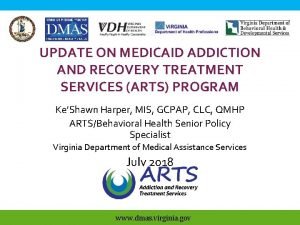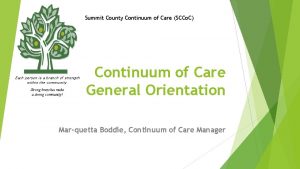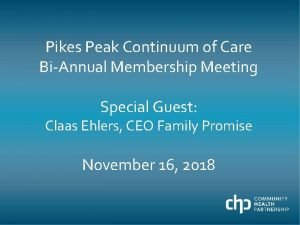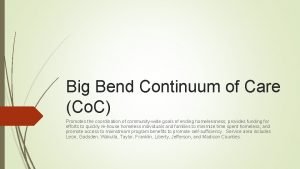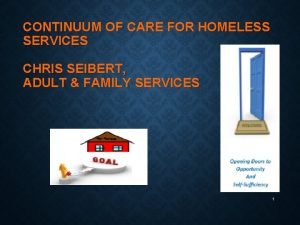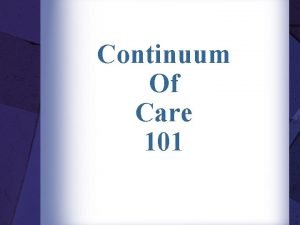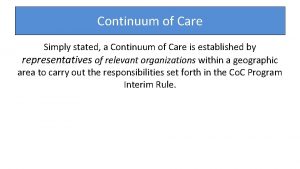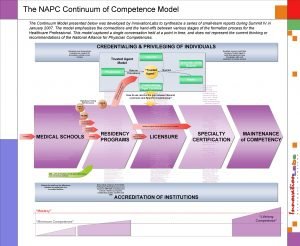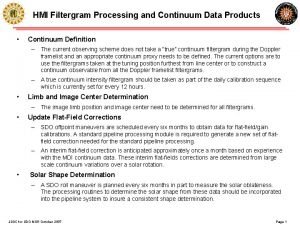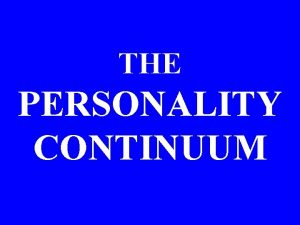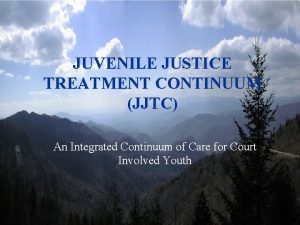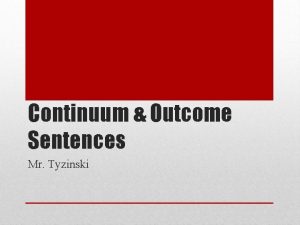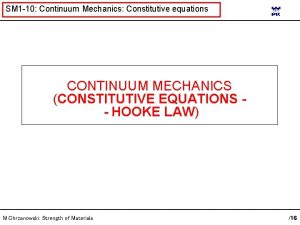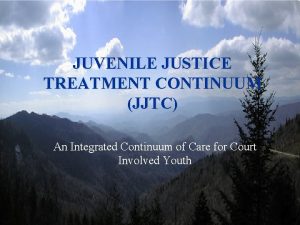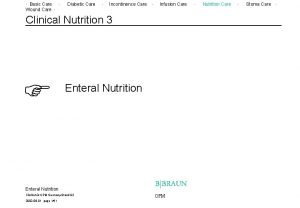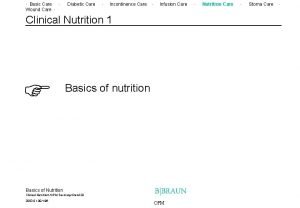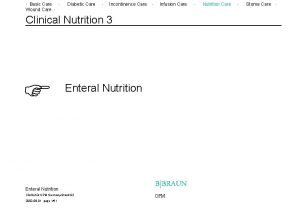THE CONTINUUM OF CARE MODULE 5 Continuum of


















- Slides: 18

THE CONTINUUM OF CARE MODULE 5 Continuum of HIV Care, Treatment, and Prevention

What is the Continuum of Care? (1) The Continuum of Care (Co. C) is: § A network that links, coordinates, and consolidates prevention, care, treatment, and support services for HIV-positive people. § These services are provided in their homes, communities, and at health facilities. § They are usually supported by a local coordinating body/committee that is responsible for facilitating referral linkages and planning.

What is Continuum of Care? (2) The Co. C is also: § The mutually reinforcing group of services that, together, provide comprehensive support to HIV-positive people and their families with the ultimate goals of: § Increased survival (decreased morbidity and mortality). § Epidemic control (community viral load suppression).


Continuum of Care Service Spots Joint United Nations Programme on HIV/AIDS (UNAIDS) and World Health Organization (WHO). 2000. Key Elements in HIV/AIDS Care and Support. Geneva: UNAIDS and WHO.

Core Services of the Co. C: Overall (1) § Are locally defined. § Include range of services related to: § Early HIV testing services. § Prompt linkage to care. § Immediate treatment initiation. § Customised support. § Ongoing combination prevention.

Core Services of the Co. C: Overall (2) Include community and clinic-based services networked across the continua of: § Holistic health and well-being § Mental, physical, spiritual, and social § HIV Treatment § ART ongoing clinical monitoring § End-of-life care § Multi-disciplinary care, bereavement support § Different level of service § Community, parish, specialised referral sites

Why Establish a Co. C? Many reasons, including: § Enhancing the health and well-being of people living with HIV. § To support increased self management of HIV. § Better adherence to antiretroviral therapy (ART). § Reducing stigma and discrimination towards people living with HIV. § Reduced costs of service delivery coupled with improved outcomes.

Guiding Principles of a Co. C § Needs-based and client-focused. § Rights-based orientation. § Meaningful involvement of people living with HIV. § Links a diverse set of services across different service delivery sites/providers. § Locally-defined design strategy.

How is a Co. C Created? Co. C planners build and sustain a Co. C by: § Working with people living with HIV to design individualised Co. C. § Linking people living with HIV to existing services. § Building on those services to create enhanced care that is centrally available. § Advocating for and creating other needed services that are not available or accessible to people living with HIV.

Putting a Co. C in Place Step-by-step guides exist for how to establish a Co. C with key building blocks. Involving people living with HIV includes: § Working with them to design a Co. C. § Promoting them as leaders in managing Co. C. § Building their capacity to provide services. § Empowering people living with HIV groups to influence, secure funds, and implement programmes. § Including them in Co. C monitoring activities. For further details, see “Building Block 4, ” pages 57 -62 of Family Health International (FHI). 2007. Scaling Up the Continuum of Care for People Living with HIV in Asia and the Pacific: A Toolkit for Implementers. Bangkok: FHI.

Operational Tools to Build a Co. C § Directory of services § Care plan matrix § Networking § Referral system

Core Services of the Co. C (1) Most Co. Cs include the following services: § Early HIV counselling and testing § ART and adherence counselling support § Routine clinical monitoring § § § Viral load, CD 4, clinical exam Opportunistic infection prevention and management Tuberculosis detection, prevention, and treatment Screening for sexually transmitted infections Cervical cancer screening Pregnancy testing

Core Services of the Co. C (2) Co. C networks include most/all of the following services: § Nutritional and daily living screening and support § Psychosocial support: § Peer navigators/educators § Peer support groups § Family planning and reproductive health § Care, support, and protection for orphans and vulnerable children

Core Services of the Co. C (3) Co. C networks include most/all of the following palliative care services: § Treatment of pain and other symptoms § Psychosocial and spiritual support § End-of-life care § Bereavement support

Core Services of the Co. C (4) Co. C networks include most/all of the following preventive services: § HIV prevention health services for people living with HIV and discordant couples § Prevention-of-mother-to-child-transmission § Health and support services for HIV-positive mothers and infants § Post-exposure prophylaxis

Core Services of the Co. C (5) Co. C networks include prevention services for those most at risk including: § Sex workers § Men having sex with men § Prisoners § Migrants § Adolescents and young adults § People who inject drugs

Resources Family Health International. 2007. Scaling up the Continuum of Care for People Living with HIV in Asia and the Pacific: A Toolkit for Implementers. Available at: http: //pdf. usaid. gov/pdf_docs/PNADK 636. pdf. Fujita, M. , K. Poudel, N. D. Thi, D. B. Duc, K. Nguyen, et. al. 2012. “A new analytic framework of ‘continuum of prevention and care’ to maximize HIV case detection and retention in care in Vietnam. ” BMC Health Services Research, 12: 483. Available at: http: //www. ncbi. nlm. nih. gov/pmc/articles/PMC 3576318/pdf/1472 -6963 -12 -483. pdf. Joint United Nations Programme on HIV/AIDS (UNAIDS) and World Health Organization (WHO). 2000. Key Elements in HIV/AIDS Care and Support. Geneva: UNAIDS and WHO.
 Primary secondary tertiary medical care
Primary secondary tertiary medical care C device module module 1
C device module module 1 Asam continuum of care
Asam continuum of care Summit county continuum of care
Summit county continuum of care Care continuum prior authorization
Care continuum prior authorization Pikes peak continuum of care
Pikes peak continuum of care Continuum care greensboro nc
Continuum care greensboro nc Continuum
Continuum Continuum of care
Continuum of care Continuum of care
Continuum of care Continuum of care reform
Continuum of care reform Hát kết hợp bộ gõ cơ thể
Hát kết hợp bộ gõ cơ thể Bổ thể
Bổ thể Tỉ lệ cơ thể trẻ em
Tỉ lệ cơ thể trẻ em Voi kéo gỗ như thế nào
Voi kéo gỗ như thế nào Thang điểm glasgow
Thang điểm glasgow Chúa sống lại
Chúa sống lại Môn thể thao bắt đầu bằng chữ f
Môn thể thao bắt đầu bằng chữ f


